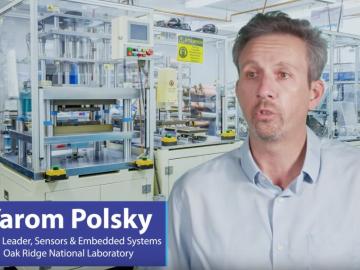
Filter News
Area of Research
- Advanced Manufacturing (1)
- Biology and Environment (18)
- Computational Biology (1)
- Computational Engineering (3)
- Computer Science (6)
- Energy Science (23)
- Fusion Energy (1)
- Isotopes (2)
- Materials (26)
- Materials for Computing (3)
- Mathematics (1)
- National Security (10)
- Neutron Science (20)
- Nuclear Science and Technology (3)
- Quantum information Science (1)
- Supercomputing (36)
News Type
News Topics
- (-) Artificial Intelligence (51)
- (-) Big Data (25)
- (-) Biomedical (28)
- (-) Clean Water (16)
- (-) Machine Learning (27)
- (-) Mercury (5)
- (-) Physics (30)
- (-) Summit (30)
- 3-D Printing/Advanced Manufacturing (82)
- Advanced Reactors (25)
- Bioenergy (42)
- Biology (47)
- Biotechnology (14)
- Buildings (36)
- Chemical Sciences (48)
- Composites (23)
- Computer Science (105)
- Coronavirus (28)
- Critical Materials (23)
- Cybersecurity (20)
- Education (3)
- Element Discovery (1)
- Emergency (1)
- Energy Storage (75)
- Environment (86)
- Exascale Computing (14)
- Fossil Energy (2)
- Frontier (17)
- Fusion (26)
- Grid (38)
- High-Performance Computing (44)
- Hydropower (6)
- Irradiation (2)
- Isotopes (25)
- ITER (5)
- Materials (96)
- Materials Science (90)
- Mathematics (3)
- Microelectronics (1)
- Microscopy (28)
- Molten Salt (8)
- Nanotechnology (41)
- National Security (21)
- Neutron Science (81)
- Nuclear Energy (47)
- Partnerships (33)
- Polymers (23)
- Quantum Computing (18)
- Quantum Science (42)
- Security (13)
- Simulation (19)
- Space Exploration (13)
- Statistics (2)
- Transportation (62)
Media Contacts

The U.S. Department of Energy’s Office of Science announced allocations of supercomputer access to 47 science projects for 2020.

Processes like manufacturing aircraft parts, analyzing data from doctors’ notes and identifying national security threats may seem unrelated, but at the U.S. Department of Energy’s Oak Ridge National Laboratory, artificial intelligence is improving all of these tasks.

The National Alliance for Water Innovation, a partnership of the Department of Energy’s Oak Ridge National Laboratory, other national labs, university and private sector partners, has been awarded a five-year, $100 million Energy-Water Desalination Hub by DOE to address water security issues in the United States.

In collaboration with the Department of Veterans Affairs, a team at Oak Ridge National Laboratory has expanded a VA-developed predictive computing model to identify veterans at risk of suicide and sped it up to run 300 times faster, a gain that could profoundly affect the VA’s ability to reach susceptible veterans quickly.

IDEMIA Identity & Security USA has licensed an advanced optical array developed at Oak Ridge National Laboratory. The portable technology can be used to help identify individuals in challenging outdoor conditions.

Oak Ridge National Laboratory is training next-generation cameras called dynamic vision sensors, or DVS, to interpret live information—a capability that has applications in robotics and could improve autonomous vehicle sensing.

Using the Titan supercomputer at Oak Ridge National Laboratory, a team of astrophysicists created a set of galactic wind simulations of the highest resolution ever performed. The simulations will allow researchers to gather and interpret more accurate, detailed data that elucidates how galactic winds affect the formation and evolution of galaxies.

A new method developed at Oak Ridge National Laboratory improves the energy efficiency of a desalination process known as solar-thermal evaporation.

Scientists at Oak Ridge National Laboratory studying quantum communications have discovered a more practical way to share secret messages among three parties, which could ultimately lead to better cybersecurity for the electric grid

Researchers at Oak Ridge National Laboratory are taking inspiration from neural networks to create computers that mimic the human brain—a quickly growing field known as neuromorphic computing.


